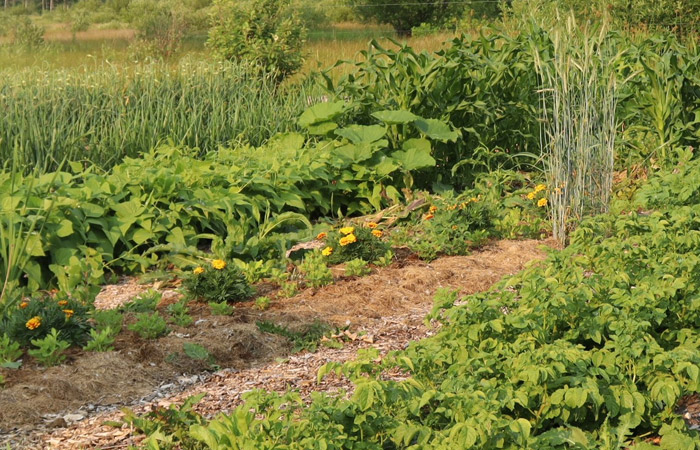In part one of this series, we looked at evaluating your garden space, companion planting and starting plants indoors. So what’s next? Well, you can simply put your seeds and dutifully cared-for bedding plants in the ground and hope for the best, or you can take some measures to maximize the health and productivity of your crops.
As the weather warms up and the ground thaws, it’s important to prepare your bedding plants for the big move to their summer home. Plants grown under “full-spectrum” lights, or even in a greenhouse, have limited to no exposure to UV light or wind. This makes them vulnerable to sun scald and wind damage if the move is too sudden. Therefore, it’s crucial to go through the process of “hardening off”. This involves gradually introducing your plants to the great outdoors over the course of about two weeks. Plan to make the final move in early June when the risk of frost is all but gone. (Too many times I’ve lost all of my plants to frost or spent my evenings running around covering them shortly after I put them in the ground.)
The first day or two, put your plants out for a couple hours in the morning, before 10:00. The sun is strongest between 10:00 and 2:00 so it’s good to avoid this time period at first. Keep the plants inside during windy days until the stems have had enough gentle jostling to strengthen up. Each day, continue to increase sun and wind exposure. If any leaves turn white, it means they’ve been sunburned. There is no cure for sun scald or wind damage – though the plants will likely survive, it may set them back a week or more. If you have a lot of plants, moving them in and out every day can get old, so you may choose to leave them outside overnight. Keep in mind that temperatures of 10 degrees or lower will stunt their growth.
The hardening off period is a good time to prepare your garden beds and think about how you’re going to manage weeds. If you have compost or manure that’s aged for at least a year (no raw poop!), add it to your soil, lightly mixing it in with a rake or hoe (or your hand if you have a small space). Compost doesn’t need to be deep – rain and worms do an excellent job of dispersing it. Alternatively, if you have limited compost, you can put a couple handfuls in each hole before you put your plants in.
Weed control plays an important role in determining the success of your garden. How you go about it will be based on the size of your garden space, the amount of time you’re willing or able to spend on it, and your physical ability. This is where raised beds shine. Weeds are much easier to pull from soil that’s not compacted by walking on, plus they are less prone to “weed creep”.
By far, the best way to control weeds is by mulching the soil (laying down a weed barrier) around your plants. Mulch shades the ground and keep weeds from sprouting. It also helps to retain soil moisture. Just make sure the soil isn’t really wet or dry when you apply the mulch.
By reducing weeds, you can greatly reduce the need to till, which wreaks havoc on soil fungi. Soil fungi play a critical role in soil and plant health, creating small aggregates out of soil particles with their multitude of fine filaments. They also produce a protein called glomalin that acts like a sticky glue. Soil aggregates are what create the pores and channels that air and water move through. They are also necessary for nutrient retention (sand leaches nutrients much faster than loam or clay). Tilling also damages worm populations.
There are many things you can use as mulch – straw, seed-free hay, wood chips, cardboard or thick newspaper weighed down with wood chips, shredded paper, cooked grass clippings, raw wool or black plastic. Fresh grass clippings often harbour seeds that will leave you beating back a lawn if you don’t cook them first. Cooking simply involves piling them up and leaving them for a few days to a week. The high nitrogen content will cause them to heat up on their own, reaching a temperature high enough to create steam and kill any seeds. Mulches with a high nitrogen content are especially attractive to worms.
Mulching may involve a lot of work up front, but it’ll save you a lot of time and stress later on. If you don’t use mulch, try to keep on top of the weeds by hoeing them when they’re just an inch or two tall. Anything larger will need to be pulled by hand. The benefit of pulling larger weeds is that they can be used as mulch (provided they haven’t gone to seed). Lay them down on the soil like shingles, with the roots of each successive bunch overlapping the leaves of the previous bunch. This way they will shade the soil without re-rooting themselves.
Keep in mind that most weeds make excellent table fare. Lamb’s-quarters (wild spinach), portulaca, red root pigweed, dandelions, wild sorrel (dock), chickweed and others are great in salads and sandwiches, soups, breads and even desserts, rivalling planted crops in both flavour and nutrients. (See my book, Laura Reeves’ Guide to Useful Plants – From Acorns to Zoom Sticks to learn more.)
One last thing to consider is protecting your garden from herbivorous animals and cats. Your strategy will depend on the types of critters you have (deer, raccoons, ground squirrels, pocket gophers), and what they’re attracted to. Protection may be as simple as placing your potted plants out of reach, or as complex as building a fence that can keep everyone out. But chances are you’ll have to employ a combination of protective measures. Scare crows, talk radio, motion-sensored sprinklers and stinky water all have their place, but no matter what you do, someone is likely to find a way around it. For this reason, it’s a good idea to split your crops up – put some beans here and some over there, for example – and plant more than you think you’ll need.
Despite taking all of these measures, there will always be influences beyond our control – inclement weather or a visit from the neighbour’s cattle. Every year is different, holding unique lessons, successes, and even losses, but it all adds up to the joy and allure of gardening.




